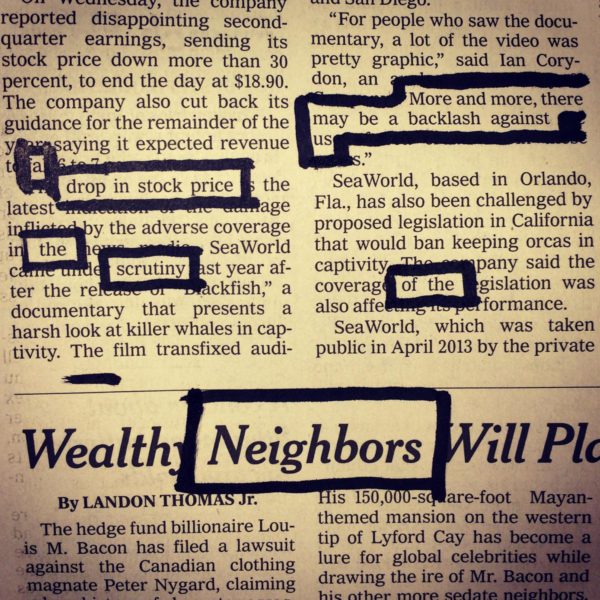
I have this Oblique Strategy hanging up in my studio. Note that it says WHEN IN DOUBT. It doesn’t say ALWAYS. Tidying up is for when I’m stalled out or stuck. Tidying up a studio is, sorry Marie, not life-changing or magical, it’s just a form of productive procrastination. It’s avoiding work by doing other work.
The best thing about tidying is that it busies my hands and loosens up my mind so that a) I get unstuck with a new idea or I solve a problem in my head b) I come across something in the mess that leads to new work, like whenever I come across an unfinished poem that’s been buried in a stack of papers or blown across the garage by the air conditioner:

The best studio tidying is a kind of exploring — I’m re-discovering spaces as I sift through the objects that occupy them. The reason I tidy is not to clean, but to come into contact with something special that I’ve forgotten that I can now use. This is a slow, dreamy, ruminative, reminiscent form of tidying.
When I come across a long-lost book, for example, I open it to random pages, give it a browse, see if it has anything to tell me. I often stop tidying because I get swept up in reading. This is the exact opposite of the kind of tidying Kondo prescribes:
Once you have piled your books, take them in your hand one by one and decide whether you want to keep or discard each one. The criterion is, of course, whether or not it gives you a thrill of pleasure when you touch it. Remember, I said when you touch it. Make sure you don’t start reading it. Reading clouds your judgment. Instead of asking yourself what you feel, you’ll start asking whether you need that book or not.
This might be a good time to mention that while The Life-Changing Magic of Tidying Up can work wonders on your sock drawer or your kitchen pantry, I have serious doubts about its usefulness to artists and creative people. Some of my favorite artists not only have messy studios, they have intentionally messy studios, because they understand that creativity is about connections, and connections are not made by siloing everything off into its own space. New ideas are formed by interesting juxtapositions, and interesting juxtapositions happen when things are out of place.
You think that if your studio is tidy, it will free you up to be more efficient, and therefore, you will produce more. Maybe that will help you if you’re a printmaker pulling prints, but it won’t help you come up with an interesting design for the next print.
It is always a mistake to equate productivity and creativity. They are not the same. In fact, they’re often at odds with each other: one is often most creative when one is least productive.
Of course there’s such a thing as too much clutter. It’s hard to work if you can’t find the tools you need when you need them. My friend John Unger has an interesting take on this, by making a distinction between tools and materials:
My rule is— keep your tools very organized so you can find them. Let the materials cross pollinate in a mess. Some pieces of art I made were utter happenstance where a couple items came together in a pile and the piece was mostly done. But if you can’t lay your hands right on the tool you need, you can blow a day (or your enthusiasm/inspiration) seeking it.
Let’s return to books. “Books are made out of other books,” as Cormac McCarthy says. Books are, for the writer, a material. And you never know which one you’re going to need, which is why writers like Nassim Taleb advocate for an “antilibrary,” or a library full of books you haven’t read. This requires collecting books, and collecting books that you’re not sure you’re even going to need. Sometimes, a library is better if the books aren’t organized. Coming across unrelated book spines on the shelf can lead to even more ideas. (See Nina Katchadourian’s Sorted Books project.)
Also: art is not only made from things that “spark joy.” Art can be made, also, out of what is ugly, or repulsive. (Says the man who just yesterday collected litter on the side of the road and taped it into his notebook. Garbage in, art out.)
I wrote in Steal Like An Artist that artists are collectors, “not hoarders, mind you, there’s a difference,” but I’m starting to suspect that the difference is pretty small. (I come from a long line of pack rats.)
While I find the Kondo craze mostly benign, I do think there’s something insidious about what Ian Svenonius calls the “war on hoarders,” in which Americans are being convinced to give up all their paper books and CDs and other material clutter and embrace the digital cloud, accessed by sleek machines sold and controlled by powerful corporations.
“ALL POWER TO THE PACKRATS!” Svenonius exclaims in Censorship Now!! He knights hoarders as “the only thing standing between the incomprehensibly rich, all-controlling, degenerate, digital despots and the absolute destruction of any deviant or alternative consciousness.” (Let’s not forget that Winston Smith’s first transgression in 1984 is owning and writing in a paper diary.) If part of the artist’s job is to be that alternate consciousness, then we must keep our weird stuff around — stuff that other people find no value in.
“Stuff is important,” said George Carlin. “You gotta take care of your stuff. You gotta have a PLACE for your stuff. Everybody’s gotta have a place for his stuff. That’s what life is all about, tryin’ to find a place for your stuff!”
So, yeah, tidy up. But not too much.